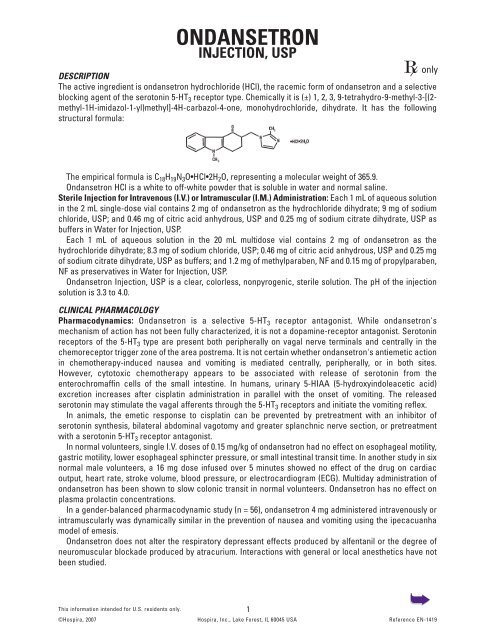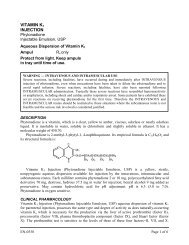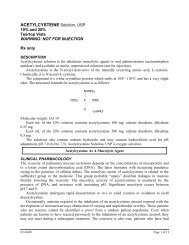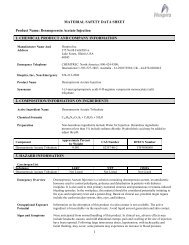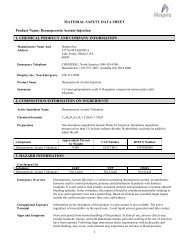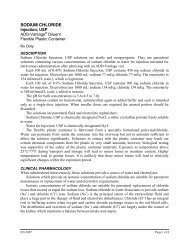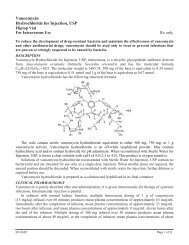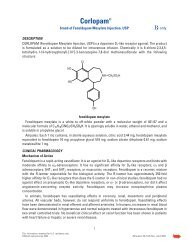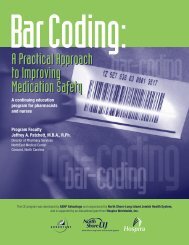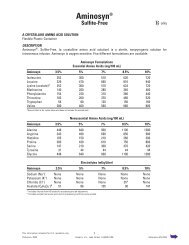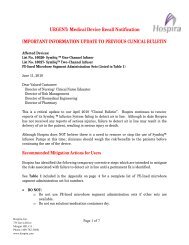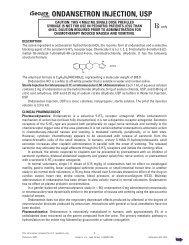ONDANSETRON - Hospira
ONDANSETRON - Hospira
ONDANSETRON - Hospira
Create successful ePaper yourself
Turn your PDF publications into a flip-book with our unique Google optimized e-Paper software.
<strong>ONDANSETRON</strong><br />
INJECTION, USP<br />
DESCRIPTION<br />
The active ingredient is ondansetron hydrochloride (HCl), the racemic form of ondansetron and a selective<br />
blocking agent of the serotonin 5-HT 3 receptor type. Chemically it is (±) 1, 2, 3, 9-tetrahydro-9-methyl-3-[(2methyl-1H-imidazol-1-yl)methyl]-4H-carbazol-4-one,<br />
monohydrochloride, dihydrate. It has the following<br />
structural formula:<br />
The empirical formula is C 18H 19N 3O•HCl•2H 2O, representing a molecular weight of 365.9.<br />
Ondansetron HCl is a white to off-white powder that is soluble in water and normal saline.<br />
Sterile Injection for Intravenous (I.V.) or Intramuscular (I.M.) Administration: Each 1 mL of aqueous solution<br />
in the 2 mL single-dose vial contains 2 mg of ondansetron as the hydrochloride dihydrate; 9 mg of sodium<br />
chloride, USP; and 0.46 mg of citric acid anhydrous, USP and 0.25 mg of sodium citrate dihydrate, USP as<br />
buffers in Water for Injection, USP.<br />
Each 1 mL of aqueous solution in the 20 mL multidose vial contains 2 mg of ondansetron as the<br />
hydrochloride dihydrate; 8.3 mg of sodium chloride, USP; 0.46 mg of citric acid anhydrous, USP and 0.25 mg<br />
of sodium citrate dihydrate, USP as buffers; and 1.2 mg of methylparaben, NF and 0.15 mg of propylparaben,<br />
NF as preservatives in Water for Injection, USP.<br />
Ondansetron Injection, USP is a clear, colorless, nonpyrogenic, sterile solution. The pH of the injection<br />
solution is 3.3 to 4.0.<br />
CLINICAL PHARMACOLOGY<br />
Pharmacodynamics: Ondansetron is a selective 5-HT 3 receptor antagonist. While ondansetron's<br />
mechanism of action has not been fully characterized, it is not a dopamine-receptor antagonist. Serotonin<br />
receptors of the 5-HT 3 type are present both peripherally on vagal nerve terminals and centrally in the<br />
chemoreceptor trigger zone of the area postrema. It is not certain whether ondansetron's antiemetic action<br />
in chemotherapy-induced nausea and vomiting is mediated centrally, peripherally, or in both sites.<br />
However, cytotoxic chemotherapy appears to be associated with release of serotonin from the<br />
enterochromaffin cells of the small intestine. In humans, urinary 5-HIAA (5-hydroxyindoleacetic acid)<br />
excretion increases after cisplatin administration in parallel with the onset of vomiting. The released<br />
serotonin may stimulate the vagal afferents through the 5-HT 3 receptors and initiate the vomiting reflex.<br />
In animals, the emetic response to cisplatin can be prevented by pretreatment with an inhibitor of<br />
serotonin synthesis, bilateral abdominal vagotomy and greater splanchnic nerve section, or pretreatment<br />
with a serotonin 5-HT 3 receptor antagonist.<br />
In normal volunteers, single I.V. doses of 0.15 mg/kg of ondansetron had no effect on esophageal motility,<br />
gastric motility, lower esophageal sphincter pressure, or small intestinal transit time. In another study in six<br />
normal male volunteers, a 16 mg dose infused over 5 minutes showed no effect of the drug on cardiac<br />
output, heart rate, stroke volume, blood pressure, or electrocardiogram (ECG). Multiday administration of<br />
ondansetron has been shown to slow colonic transit in normal volunteers. Ondansetron has no effect on<br />
plasma prolactin concentrations.<br />
In a gender-balanced pharmacodynamic study (n = 56), ondansetron 4 mg administered intravenously or<br />
intramuscularly was dynamically similar in the prevention of nausea and vomiting using the ipecacuanha<br />
model of emesis.<br />
Ondansetron does not alter the respiratory depressant effects produced by alfentanil or the degree of<br />
neuromuscular blockade produced by atracurium. Interactions with general or local anesthetics have not<br />
been studied.<br />
1<br />
� only<br />
This information intended for U.S. residents only.<br />
©<strong>Hospira</strong>, 2007 <strong>Hospira</strong>, Inc., Lake Forest, IL 60045 USA Reference EN-1419
<strong>ONDANSETRON</strong><br />
INJECTION, USP<br />
Pharmacokinetics: Ondansetron is extensively metabolized in humans, with approximately 5% of a<br />
radiolabeled dose recovered as the parent compound from the urine. The primary metabolic pathway is<br />
hydroxylation on the indole ring followed by glucuronide or sulfate conjugation.<br />
Although some nonconjugated metabolites have pharmacologic activity, these are not found in plasma at<br />
concentrations likely to significantly contribute to the biological activity of ondansetron.<br />
In vitro metabolism studies have shown that ondansetron is a substrate for human hepatic cytochrome<br />
P-450 enzymes, including CYP1A2, CYP2D6, and CYP3A4. In terms of overall ondansetron turnover,<br />
CYP3A4 played the predominant role. Because of the multiplicity of metabolic enzymes capable of<br />
metabolizing ondansetron, it is likely that inhibition or loss of one enzyme (e.g., CYP2D6 genetic deficiency)<br />
will be compensated by others and may result in little change in overall rates of ondansetron elimination.<br />
Ondansetron elimination may be affected by cytochrome P-450 inducers. In a pharmacokinetic study of<br />
16 epileptic patients maintained chronically on CYP3A4 inducers, carbamazepine or phenytoin, reduction<br />
in AUC, C max and T 1/2 of ondansetron was observed. 1 This resulted in a significant increase in clearance.<br />
However, on the basis of available data, no dosage adjustment for ondansetron is recommended (see<br />
PRECAUTIONS: Drug Interactions).<br />
In humans, carmustine, etoposide, and cisplatin do not affect the pharmacokinetics of ondansetron.<br />
In normal adult volunteers, the following mean pharmacokinetic data have been determined following a<br />
single 0.15 mg/kg I.V. dose.<br />
Table 1. Pharmacokinetics in Normal Adult Volunteers<br />
Peak<br />
Age Plasma Mean Plasma<br />
group Concentration Elimination Clearance<br />
(years) n (ng/mL) Half-life (h) (L/h/kg)<br />
19-40 11 102 3.5 0.381<br />
61-74 12 106 4.7 0.319<br />
≥75 11 170 5.5 0.262<br />
A reduction in clearance and increase in elimination half-life are seen in patients over 75 years of age. In<br />
clinical trials with cancer patients, safety and efficacy were similar in patients over 65 years of age and<br />
those under 65 years of age; there was an insufficient number of patients over 75 years of age to permit<br />
conclusions in that age group. No dosage adjustment is recommended in the elderly.<br />
In patients with mild-to-moderate hepatic impairment, clearance is reduced twofold and mean half-life is<br />
increased to 11.6 hours compared to 5.7 hours in normals. In patients with severe hepatic impairment<br />
(Child-Pugh2 score of 10 or greater), clearance is reduced twofold to threefold and apparent volume of<br />
distribution is increased with a resultant increase in half-life to 20 hours. In patients with severe hepatic<br />
impairment, a total daily dose of 8 mg should not be exceeded.<br />
Due to the very small contribution (5%) of renal clearance to the overall clearance, renal impairment was<br />
not expected to significantly influence the total clearance of ondansetron. However, ondansetron mean<br />
plasma clearance was reduced by about 41% in patients with severe renal impairment (creatinine<br />
clearance
<strong>ONDANSETRON</strong><br />
INJECTION, USP<br />
ondansetron plasma half-life may result in differences in efficacy between adults and some young pediatric<br />
patients (see CLINICAL TRIALS: Pediatric Studies).<br />
Pharmacokinetic information for pediatric cancer patients 6 months to 48 months of age is approved for<br />
GlaxoSmithKline Corporation’s ondansetron injection. However, due to GlaxoSmithKline’s marketing<br />
exclusivity rights, this drug product is not labeled for use in this subpopulation of pediatric patients.<br />
In a study of 21 pediatric patients (3 to 12 years of age) who were undergoing surgery requiring<br />
anesthesia for a duration of 45 minutes to 2 hours, a single I.V. dose of ondansetron, 2 mg (3 to 7 years) or<br />
4 mg (8 to 12 years), was administered immediately prior to anesthesia induction. Mean weight-normalized<br />
clearance and volume of distribution values in these pediatric surgical patients were similar to those<br />
previously reported for young adults. Mean terminal half-life was slightly reduced in pediatric patients<br />
(range, 2.5 to 3 hours) in comparison with adults (range, 3 to 3.5 hours).<br />
Table 2. Pharmacokinetics in Pediatric Surgery Patients 1 Month to 12 Years of Age<br />
CL Vdss T1⁄2 Subjects and Age Group N (L/h/kg) (L/kg) (h)<br />
Geometric Mean Mean<br />
Pediatric Surgery Patients N = 21 0.439 1.65 2.9<br />
3 to 12 years of Age<br />
Pediatric Surgery Patients N = 22 0.581 2.3 2.9<br />
5 to 24 months of Age<br />
Pediatric Surgery Patients N = 19 0.401 3.5 6.7<br />
1 month to 4 months of Age<br />
In general, surgical and cancer pediatric patients younger than 18 years tend to have a higher<br />
ondansetron clearance compared to adults leading to a shorter half-life in most pediatric patients. In<br />
patients 1 month to 4 months of age, a longer half-life was observed due to the higher volume of distribution<br />
in this age group.<br />
Pharmacokinetic information for pediatric surgical patients 1 month to 24 months of age is approved for<br />
GlaxoSmithKline Corporation’s ondansetron injection. However, due to GlaxoSmithKline’s marketing<br />
exclusivity rights, this drug product is not labeled for use in this subpopulation of pediatric patients.<br />
In normal volunteers (19 to 39 years old, n = 23), the peak plasma concentration was 264 ng/mL following<br />
a single 32 mg dose administered as a 15 minute I.V. infusion. The mean elimination half-life was 4.1 hours.<br />
Systemic exposure to 32 mg of ondansetron was not proportional to dose as measured by comparing<br />
dose-normalized AUC values to an 8 mg dose. This is consistent with a small decrease in systemic<br />
clearance with increasing plasma concentrations.<br />
A study was performed in normal volunteers (n = 56) to evaluate the pharmacokinetics of a single 4 mg<br />
dose administered as a 5 minute infusion compared to a single intramuscular injection. Systemic exposure<br />
as measured by mean AUC was equivalent, with values of 156 [95% CI 136, 180] and 161 [95% CI 137,<br />
190] ng•h/mL for I.V. and I.M. groups, respectively. Mean peak plasma concentrations were 42.9 [95% CI<br />
33.8, 54.4] ng/mL at 10 minutes after I.V. infusion and 31.9 [95% CI 26.3, 38.6] ng/mL at 41 minutes after I.M.<br />
injection. The mean elimination half-life was not affected by route of administration.<br />
Plasma protein binding of ondansetron as measured in vitro was 70% to 76%, with binding constant over<br />
the pharmacologic concentration range (10 to 500 ng/mL). Circulating drug also distributes into<br />
erythrocytes.<br />
A positive lymphoblast transformation test to ondansetron has been reported, which suggests<br />
immunologic sensitivity to ondansetron.<br />
3<br />
This information intended for U.S. residents only.<br />
©<strong>Hospira</strong>, 2007 <strong>Hospira</strong>, Inc., Lake Forest, IL 60045 USA Reference EN-1419
<strong>ONDANSETRON</strong><br />
INJECTION, USP<br />
CLINICAL TRIALS<br />
Chemotherapy-Induced Nausea and Vomiting:<br />
Adult Studies: In a double-blind study of three different dosing regimens of Ondansetron Injection, USP,<br />
0.015 mg/kg, 0.15 mg/kg, and 0.30 mg/kg, each given three times during the course of cancer chemotherapy,<br />
the 0.15 mg/kg dosing regimen was more effective than the 0.015 mg/kg dosing regimen. The 0.30 mg/kg<br />
dosing regimen was not shown to be more effective than the 0.15 mg/kg dosing regimen.<br />
Cisplatin-Based Chemotherapy: In a double-blind study in 28 patients, Ondansetron Injection, USP (three<br />
0.15 mg/kg doses) was significantly more effective than placebo in preventing nausea and vomiting<br />
induced by cisplatin-based chemotherapy. Treatment response was as shown in Table 3.<br />
Table 3. Prevention of Chemotherapy-Induced Nausea and Vomiting<br />
in Single-Day Cisplatin Therapy* in Adults<br />
Ondansetron<br />
Injection, USP Placebo P Value †<br />
Number of patients 14 14<br />
Treatment response<br />
0 Emetic episodes 2 (14%) 0 (0%)<br />
1-2 Emetic episodes 8 (57%) 0 (0%)<br />
3-5 Emetic episodes 2 (14%) 1 (7%)<br />
More than 5 emetic 2 (14%) 13 (93%) 0.001<br />
episodes/rescued<br />
Median number of 1.5 Undefined ‡<br />
emetic episodes<br />
Median time to first 11.6 2.8 0.001<br />
emetic episode (h)<br />
Median nausea 3 59 0.034<br />
scores (0-100) §<br />
Global satisfaction<br />
with control of nausea<br />
and vomiting (0-100) II 96 10.5 0.009<br />
* Chemotherapy was high dose (100 and 120 mg/m 2 ; Ondansetron Injection, USP n = 6, placebo n = 5) or moderate dose (50 and 80 mg/m 2 ; Ondansetron Injection, USP<br />
n = 8, placebo n = 9). Other chemotherapeutic agents included fluorouracil, doxorubicin, and cyclophosphamide. There was no difference between treatments in the<br />
types of chemotherapy that would account for differences in response.<br />
† Efficacy based on "all patients treated" analysis.<br />
‡ Median undefined since at least 50% of the patients were rescued or had more than five emetic episodes.<br />
§ Visual analog scale assessment of nausea: 0 = no nausea, 100 = nausea as bad as it can be.<br />
II Visual analog scale assessment of satisfaction: 0 = not at all satisfied, 100 = totally satisfied.<br />
Ondansetron was compared with metoclopramide in a single-blind trial in 307 patients receiving cisplatin<br />
≥100 mg/m 2 with or without other chemotherapeutic agents. Patients received the first dose of<br />
ondansetron or metoclopramide 30 minutes before cisplatin. Two additional ondansetron doses were<br />
administered 4 and 8 hours later, or five additional metoclopramide doses were administered 2, 4, 7, 10, and<br />
13 hours later. Cisplatin was administered over a period of 3 hours or less. Episodes of vomiting and<br />
retching were tabulated over the period of 24 hours after cisplatin. The results of this study are summarized<br />
in Table 4.<br />
4<br />
This information intended for U.S. residents only.<br />
©<strong>Hospira</strong>, 2007 <strong>Hospira</strong>, Inc., Lake Forest, IL 60045 USA Reference EN-1419
<strong>ONDANSETRON</strong><br />
INJECTION, USP<br />
Table 4. Prevention of Vomiting Induced by Cisplatin<br />
(≥100 mg/m 2 ) Single-Day Therapy* in Adults<br />
Ondansetron<br />
Injection, USP Metoclopramide P Value<br />
Dose<br />
Number of<br />
patients in<br />
0.15 mg/kg x 3 2 mg/kg x 6<br />
efficacy population<br />
Treatment response<br />
136 138<br />
0 Emetic episodes 54 (40%) 41 (30%)<br />
1-2 Emetic episodes 34 (25%) 30 (22%)<br />
3-5 Emetic episodes<br />
More than 5 emetic<br />
19 (14%) 18 (13%)<br />
episodes/rescued<br />
Comparison of<br />
treatments with<br />
respect to<br />
29 (21%) 49 (36%)<br />
0 Emetic episodes<br />
More than 5 emetic<br />
54/136 41/138 0.083<br />
episodes/rescued<br />
Median number of<br />
29/136 49/138 0.009<br />
emetic episodes<br />
Median time to first<br />
1 2 0.005<br />
emetic episode (h)<br />
Global satisfaction<br />
with control of nausea<br />
20.5 4.3
<strong>ONDANSETRON</strong><br />
INJECTION, USP<br />
Table 5. Prevention of Chemotherapy-Induced Nausea and Vomiting in Single-Dose Therapy in Adults<br />
Ondansetron<br />
Dose<br />
0.15 mg/kg x 3 32 mg x 1 P Value<br />
High-dose cisplatin<br />
(≥100 mg/m 2 )<br />
Number of patients 100 102<br />
Treatment response<br />
0 Emetic episodes 41 (41%) 49 (48%) 0.315<br />
1-2 Emetic episodes 19 (19%) 25 (25%)<br />
3-5 Emetic episodes 4 (4%) 8 (8%)<br />
More than 5 emetic<br />
episodes/rescued 36 (36%) 20 (20%) 0.009<br />
Median time to first<br />
emetic episode (h) 21.7 23 0.173<br />
Median nausea<br />
scores (0-100)* 28 13 0.004<br />
Medium-dose cisplatin<br />
(50-70 mg/m 2 )<br />
Number of patients 101 93<br />
Treatment response<br />
0 Emetic episodes 62 (61%) 68 (73%) 0.083<br />
1-2 Emetic episodes 11 (11%) 14 (15%)<br />
3-5 Emetic episodes 6 (6%) 3 (3%)<br />
More than 5 emetic<br />
episodes/rescued 22 (22%) 8 (9%) 0.011<br />
Median time to first<br />
emetic episode (h) Undefined † Undefined<br />
Median nausea<br />
scores (0-100)* 9 3 0.131<br />
* Visual analog scale assessment: 0 = no nausea, 100 = nausea as bad as it can be.<br />
† Median undefined since at least 50% of patients did not have any emetic episodes.<br />
Cyclophosphamide-Based Chemotherapy: In a double-blind, placebo-controlled study of Ondansetron<br />
Injection, USP (three 0.15 mg/kg doses) in 20 patients receiving cyclophosphamide (500 to 600 mg/m 2 )<br />
chemotherapy, Ondansetron Injection, USP was significantly more effective than placebo in preventing<br />
nausea and vomiting. The results are summarized in Table 6.<br />
6<br />
This information intended for U.S. residents only.<br />
©<strong>Hospira</strong>, 2007 <strong>Hospira</strong>, Inc., Lake Forest, IL 60045 USA Reference EN-1419
<strong>ONDANSETRON</strong><br />
INJECTION, USP<br />
Table 6. Prevention of Chemotherapy-Induced Nausea and Vomiting in Single-Day Cyclophosphamide<br />
Therapy * in Adults<br />
Ondansetron<br />
Injection, USP Placebo P Value †<br />
Number of patients 10 10<br />
Treatment response<br />
0 Emetic episodes 7 (70%) 0 (0%) 0.001<br />
1-2 Emetic episodes 0 (0%) 2 (20%)<br />
3-5 Emetic episodes 2 (20%) 4 (40%)<br />
More than 5 emetic<br />
episodes/rescued 1 (10%) 4 (40%) 0.131<br />
Median number of<br />
emetic episodes 0 4 0.008<br />
Median time to first<br />
emetic episode (h) Undefined ‡ 8.79<br />
Median nausea scores<br />
(0-100) § 0 60 0.001<br />
Global satisfaction with<br />
control of nausea<br />
and vomiting (0-100) II 100 52 0.008<br />
* Chemotherapy consisted of cyclophosphamide in all patients, plus other agents, including fluorouracil, doxorubicin, methotrexate, and vincristine. There was no<br />
difference between treatments in the type of chemotherapy that would account for differences in response.<br />
† Efficacy based on "all patients treated" analysis.<br />
‡ Median undefined since at least 50% of patients did not have any emetic episodes.<br />
§ Visual analog scale assessment of nausea: 0 = no nausea, 100 = nausea as bad as it can be.<br />
II Visual analog scale assessment of satisfaction: 0 = not at all satisfied, 100 = totally satisfied.<br />
Re-treatment: In uncontrolled trials, 127 patients receiving cisplatin (median dose, 100 mg/m2 ) and<br />
ondansetron who had two or fewer emetic episodes were re-treated with ondansetron and chemotherapy,<br />
mainly cisplatin, for a total of 269 re-treatment courses (median, 2; range, 1 to 10). No emetic episodes<br />
occurred in 160 (59%), and two or fewer emetic episodes occurred in 217 (81%) re-treatment courses.<br />
Pediatric Studies: Four open-label, noncomparative (one US, three foreign) trials have been performed<br />
with 209 pediatric cancer patients 4 to 18 years of age given a variety of cisplatin or noncisplatin regimens.<br />
In the three foreign trials, the initial Ondansetron Injection, USP dose ranged from 0.04 to 0.87 mg/kg for a<br />
total dose of 2.16 to 12 mg. This was followed by the oral administration of ondansetron ranging from 4 to<br />
24 mg daily for 3 days. In the US trial, Ondansetron Injection, USP was administered intravenously (only) in<br />
three doses of 0.15 mg/kg each for a total daily dose of 7.2 to 39 mg. In these studies, 58% of the<br />
196 evaluable patients had a complete response (no emetic episodes) on day 1. Thus, prevention of<br />
vomiting in these pediatric patients was essentially the same as for patients older than 18 years of age.<br />
Clinical trial information in pediatric cancer patients 6 months to 48 months of age is approved for<br />
GlaxoSmithKline Corporation’s ondansetron injection. However, due to GlaxoSmithKline’s marketing<br />
exclusivity rights, this drug product is not labeled for use in this subpopulation of pediatric patients.<br />
Postoperative Nausea and Vomiting: Prevention of Postoperative Nausea and Vomiting:<br />
Adult Studies: Adult surgical patients who received ondansetron immediately before the induction of<br />
general balanced anesthesia (barbiturate: thiopental, methohexital, or thiamylal; opioid: alfentanil or<br />
fentanyl; nitrous oxide; neuromuscular blockade: succinylcholine/curare and/or vecuronium or atracurium;<br />
and supplemental isoflurane) were evaluated in two double-blind US studies involving 554 patients.<br />
Ondansetron Injection, USP (4 mg) I.V. given over 2 to 5 minutes was significantly more effective than<br />
placebo. The results of these studies are summarized in Table 7.<br />
7<br />
This information intended for U.S. residents only.<br />
©<strong>Hospira</strong>, 2007 <strong>Hospira</strong>, Inc., Lake Forest, IL 60045 USA Reference EN-1419
<strong>ONDANSETRON</strong><br />
INJECTION, USP<br />
Table 7. Prevention of Postoperative Nausea and Vomiting in Adult Patients<br />
Ondansetron<br />
4 mg I.V. Placebo P Value<br />
Study 1<br />
Emetic episodes:<br />
Number of patients<br />
Treatment response over<br />
24-h postoperative period<br />
136 139<br />
0 Emetic episodes 103 (76%) 64 (46%)
<strong>ONDANSETRON</strong><br />
INJECTION, USP<br />
Table 8. Prevention of Postoperative Nausea and Vomiting in Pediatric Patients 2 to 12 Years of Age<br />
Treatment Response Ondansetron Placebo<br />
Over 24 Hours n (%) n (%) P Value<br />
Study 1<br />
Number of patients 205 210<br />
0 Emetic episodes 140 (68%) 82 (39%) ≤ 0.001<br />
Failure * 65 (32%) 128 (61%)<br />
Study 2<br />
Number of patients 112 110<br />
0 Emetic episodes 68 (61%) 38 (35%) ≤ 0.001<br />
Failure * 44 (39%) 72 (65%)<br />
Study 3<br />
Number of patients 206 206<br />
0 Emetic episodes 123 (60%) 96 (47%) ≤ 0.01<br />
Failure * 83 (40%) 110 (53%)<br />
Nausea assessments † :<br />
Number of patients 185 191<br />
None 119 (64%) 99 (52%) ≤ 0.01<br />
* Failure was one or more emetic episodes, rescued, or withdrawn.<br />
† Nausea measured as none, mild, or severe.<br />
Clinical trial information in pediatric surgical patients 1 month to 24 months of age is approved for<br />
GlaxoSmithKline Corporation’s ondansetron injection. However, due to GlaxoSmithKline’s marketing<br />
exclusivity rights, this drug product is not labeled for use in this subpopulation of pediatric patients.<br />
Prevention of Further Postoperative Nausea and Vomiting:<br />
Adult Studies: Adult surgical patients receiving general balanced anesthesia (barbiturate: thiopental,<br />
methohexital, or thiamylal; opioid: alfentanil or fentanyl; nitrous oxide; neuromuscular blockade:<br />
succinylcholine/curare and/or vecuronium or atracurium; and supplemental isoflurane) who received no<br />
prophylactic antiemetics and who experienced nausea and/or vomiting within 2 hours postoperatively were<br />
evaluated in two double-blind US studies involving 441 patients. Patients who experienced an episode<br />
of postoperative nausea and/or vomiting were given Ondansetron Injection, USP (4 mg) I.V. over<br />
2 to 5 minutes, and this was significantly more effective than placebo. The results of these studies are<br />
summarized in Table 9.<br />
9<br />
This information intended for U.S. residents only.<br />
©<strong>Hospira</strong>, 2007 <strong>Hospira</strong>, Inc., Lake Forest, IL 60045 USA Reference EN-1419
<strong>ONDANSETRON</strong><br />
INJECTION, USP<br />
Table 9. Prevention of Further Postoperative Nausea and Vomiting in Adult Patients<br />
Ondansetron<br />
4 mg I.V. Placebo P Value<br />
Study 1<br />
Emetic episodes:<br />
Number of patients<br />
Treatment response<br />
24 h after study drug<br />
104 117<br />
0 Emetic episodes 49 (47%) 19 (16%)
<strong>ONDANSETRON</strong><br />
INJECTION, USP<br />
weighing more than 40 kg) or placebo administered over at least 30 seconds. Ondansetron was significantly<br />
more effective than placebo in preventing further episodes of nausea and vomiting. The results of the study<br />
are summarized in Table 10.<br />
Table 10. Prevention of Further Postoperative Nausea and Vomiting in<br />
Pediatric Patients 2 to 12 Years of Age<br />
Treatment Response Ondansetron Placebo<br />
Over 24 Hours n (%) n (%) P Value<br />
Number of patients 180 171<br />
0 Emetic episodes 96 (53%) 29 (17%) ≤0.001<br />
Failure * 84 (47%) 142 (83%)<br />
* Failure was one or more emetic episodes, rescued, or withdrawn.<br />
INDICATIONS AND USAGE<br />
1. Prevention of nausea and vomiting associated with initial and repeat courses of emetogenic cancer<br />
chemotherapy, including high-dose cisplatin. Efficacy of the 32 mg single dose beyond 24 hours in these<br />
patients has not been established.<br />
2. Prevention of postoperative nausea and/or vomiting. As with other antiemetics, routine prophylaxis is not<br />
recommended for patients in whom there is little expectation that nausea and/or vomiting will occur<br />
postoperatively. In patients where nausea and/or vomiting must be avoided postoperatively,<br />
Ondansetron Injection, USP is recommended even where the incidence of postoperative nausea and/or<br />
vomiting is low. For patients who do not receive prophylactic Ondansetron Injection, USP and experience<br />
nausea and/or vomiting postoperatively, Ondansetron Injection, USP may be given to prevent further<br />
episodes (see CLINICAL TRIALS).<br />
CONTRAINDICATIONS<br />
Ondansetron Injection, USP is contraindicated for patients known to have hypersensitivity to the drug.<br />
WARNINGS<br />
Hypersensitivity reactions have been reported in patients who have exhibited hypersensitivity to other<br />
selective 5-HT 3 receptor antagonists.<br />
PRECAUTIONS<br />
General: Ondansetron is not a drug that stimulates gastric or intestinal peristalsis. It should not be used<br />
instead of nasogastric suction. The use of ondansetron in patients following abdominal surgery or in<br />
patients with chemotherapy-induced nausea and vomiting may mask a progressive ileus and/or gastric<br />
distention.<br />
Rarely and predominantly with intravenous ondansetron, transient ECG changes including QT interval<br />
prolongation have been reported.<br />
Drug Interactions: Ondansetron does not itself appear to induce or inhibit the cytochrome P-450<br />
drug-metabolizing enzyme system of the liver (see CLINICAL PHARMACOLOGY, Pharmacokinetics).<br />
Because ondansetron is metabolized by hepatic cytochrome P-450 drug-metabolizing enzymes<br />
(CYP3A4, CYP2D6, CYP1A2), inducers or inhibitors of these enzymes may change the clearance and, hence,<br />
the half-life of ondansetron. On the basis of limited available data, no dosage adjustment is recommended<br />
for patients on these drugs.<br />
Phenytoin, Carbamazepine, and Rifampicin: In patients treated with potent inducers of CYP3A4 (i.e.,<br />
phenytoin, carbamazepine and rifampicin), the clearance of ondansetron was significantly increased and<br />
ondansetron blood concentrations were decreased. However, on the basis of available data, no dosage<br />
adjustment for ondansetron is recommended for patients on these drugs. 1,3<br />
11<br />
This information intended for U.S. residents only.<br />
©<strong>Hospira</strong>, 2007 <strong>Hospira</strong>, Inc., Lake Forest, IL 60045 USA Reference EN-1419
<strong>ONDANSETRON</strong><br />
INJECTION, USP<br />
Tramadol: Although no pharmacokinetic drug interaction between ondansetron and tramadol has been<br />
observed, data from 2 small studies indicate that ondansetron may be associated with an increase in<br />
patient controlled administration of tramadol. 4,5<br />
Chemotherapy: Tumor response to chemotherapy in the P 388 mouse leukemia model is not affected by<br />
ondansetron. In humans, carmustine, etoposide and cisplatin do not affect the pharmacokinetics of<br />
ondansetron.<br />
In a crossover study in 76 pediatric patients, I.V. ondansetron did not increase blood levels of high dose<br />
methotrexate.<br />
Carcinogenesis, Mutagenesis, Impairment of Fertility: Carcinogenic effects were not seen in 2 year studies<br />
in rats and mice with oral ondansetron doses up to 10 and 30 mg/kg per day, respectively. Ondansetron was<br />
not mutagenic in standard tests for mutagenicity. Oral administration of ondansetron up to 15 mg/kg per day<br />
did not affect fertility or general reproductive performance of male and female rats.<br />
Pregnancy: Teratogenic Effects: Pregnancy Category B. Reproduction studies have been performed in<br />
pregnant rats and rabbits at I.V. doses up to 4 mg/kg per day and have revealed no evidence of impaired<br />
fertility or harm to the fetus due to ondansetron. There are, however, no adequate and well-controlled<br />
studies in pregnant women. Because animal reproduction studies are not always predictive of human<br />
response, this drug should be used during pregnancy only if clearly needed.<br />
Nursing Mothers: Ondansetron is excreted in the breast milk of rats. It is not known whether ondansetron<br />
is excreted in human milk. Because many drugs are excreted in human milk, caution should be exercised<br />
when ondansetron is administered to a nursing woman.<br />
Pediatric Use: Little information is available about the use of ondansetron in pediatric surgical patients<br />
younger than 1 month of age. Little information is available about the use of ondansetron in pediatric cancer<br />
patients younger than 6 months of age.<br />
The clearance of ondansetron in pediatric patients 1 month to 4 months of age is slower and the half-life<br />
is ~2.5 fold longer than patients who are >4 to 24 months of age. As a precaution, it is recommended<br />
that patients less than 4 months of age receiving this drug be closely monitored. (See CLINICAL<br />
PHARMACOLOGY: Pharmacokinetics.)<br />
The frequency and type of adverse events reported in pediatric patients receiving ondansetron were<br />
similar to those in patients receiving placebo.<br />
Geriatric Use: Of the total number of subjects enrolled in cancer chemotherapy-induced and postoperative<br />
nausea and vomiting in US- and foreign-controlled clinical trials, 862 were 65 years of age and over.<br />
No overall differences in safety or effectiveness were observed between these subjects and younger<br />
subjects, and other reported clinical experience has not identified differences in responses between the<br />
elderly and younger patients, but greater sensitivity of some older individuals cannot be ruled out. Dosage<br />
adjustment is not needed in patients over the age of 65 (see CLINICAL PHARMACOLOGY).<br />
ADVERSE REACTIONS<br />
Chemotherapy-Induced Nausea and Vomiting: The adverse events in Table 11 have been reported in adults<br />
receiving ondansetron at a dosage of three 0.15 mg/kg doses or as a single 32 mg dose in clinical trials.<br />
These patients were receiving concomitant chemotherapy, primarily cisplatin, and I.V. fluids. Most were<br />
receiving a diuretic.<br />
12<br />
This information intended for U.S. residents only.<br />
©<strong>Hospira</strong>, 2007 <strong>Hospira</strong>, Inc., Lake Forest, IL 60045 USA Reference EN-1419
<strong>ONDANSETRON</strong><br />
INJECTION, USP<br />
Table 11. Principal Adverse Events in Comparative Trials in Adults<br />
Number of Adult Patients With Event<br />
Ondansetron Ondansetron<br />
Injection, USP Injection, USP<br />
0.15 mg/kg x 3 32 mg x 1 Metoclopramide Placebo<br />
n = 419 n = 220 n = 156 n = 34<br />
Diarrhea 16% 8% 44% 18%<br />
Headache 17% 25% 7% 15%<br />
Fever 8% 7% 5% 3%<br />
Akathisia 0% 0% 6% 0%<br />
Acute<br />
dystonic<br />
reactions * 0% 0% 5% 0%<br />
* See Neurological.<br />
The following have been reported during controlled clinical trials:<br />
Cardiovascular: Rare cases of angina (chest pain), electrocardiographic alterations, hypotension, and<br />
tachycardia have been reported. In many cases, the relationship to Ondansetron Injection, USP was<br />
unclear.<br />
Gastrointestinal: Constipation has been reported in 11% of chemotherapy patients receiving multiday<br />
ondansetron.<br />
Hepatic: In comparative trials in cisplatin chemotherapy patients with normal baseline values of<br />
aspartate transaminase (AST) and alanine transaminase (ALT), these enzymes have been reported to<br />
exceed twice the upper limit of normal in approximately 5% of patients. The increases were transient and<br />
did not appear to be related to dose or duration of therapy. On repeat exposure, similar transient elevations<br />
in transaminase values occurred in some courses, but symptomatic hepatic disease did not occur.<br />
Integumentary: Rash has occurred in approximately 1% of patients receiving ondansetron.<br />
Neurological: There have been rare reports consistent with, but not diagnostic of, extrapyramidal<br />
reactions in patients receiving ondansetron, and rare cases of grand mal seizure. The relationship to<br />
ondansetron was unclear.<br />
Other: Rare cases of hypokalemia have been reported. The relationship to Ondansetron Injection, USP<br />
was unclear.<br />
Postoperative Nausea and Vomiting: The adverse events in Table 12 have been reported in ≥2% of adults<br />
receiving ondansetron at a dosage of 4 mg I.V. over 2 to 5 minutes in clinical trials. Rates of these events<br />
were not significantly different in the ondansetron and placebo groups. These patients were receiving<br />
multiple concomitant perioperative and postoperative medications.<br />
13<br />
This information intended for U.S. residents only.<br />
©<strong>Hospira</strong>, 2007 <strong>Hospira</strong>, Inc., Lake Forest, IL 60045 USA Reference EN-1419
<strong>ONDANSETRON</strong><br />
INJECTION, USP<br />
Table 12. Adverse Events in ≥2% of Adults Receiving Ondansetron at a Dosage of 4 mg I.V. over 2 to 5<br />
Minutes in Clinical Trials<br />
Ondansetron<br />
Injection, USP 4 mg I.V. Placebo<br />
n = 547 patients n = 547 patients<br />
Headache 92 (17%) 77 (14%)<br />
Dizziness 67 (12%) 88 (16%)<br />
Musculoskeletal pain 57 (10%) 59 (11%)<br />
Drowsiness/sedation 44 (8%) 37 (7%)<br />
Shivers 38 (7%) 39 (7%)<br />
Malaise/fatigue 25 (5%) 30 (5%)<br />
Injection site reaction 21 (4%) 18 (3%)<br />
Urinary retention<br />
Postoperative<br />
17 (3%) 15 (3%)<br />
CO2-related pain * 12 (2%) 16 (3%)<br />
Chest pain (unspecified) 12 (2%) 15 (3%)<br />
Anxiety/agitation 11 (2%) 16 (3%)<br />
Dysuria 11 (2%) 9 (2%)<br />
Hypotension 10 (2%) 12 (2%)<br />
Fever 10 (2%) 6 (1%)<br />
Cold sensation 9 (2%) 8 (1%)<br />
Pruritus 9 (2%) 3 (
<strong>ONDANSETRON</strong><br />
INJECTION, USP<br />
they are reported voluntarily from a population of unknown size, estimates of frequency cannot be made.<br />
The events have been chosen for inclusion due to a combination of their seriousness, frequency of<br />
reporting, or potential causal connection to ondansetron.<br />
Cardiovascular: Arrhythmias (including ventricular and supraventricular tachycardia, premature<br />
ventricular contractions, and atrial fibrillation), bradycardia, electrocardiographic alterations (including<br />
second-degree heart block, QT interval prolongation, and ST segment depression), palpitations, and<br />
syncope.<br />
General: Flushing. Rare cases of hypersensitivity reactions, sometimes severe (e.g.,<br />
anaphylaxis/anaphylactoid reactions, angioedema, bronchospasm, cardiopulmonary arrest, hypotension,<br />
laryngeal edema, laryngospasm, shock, shortness of breath, stridor) have also been reported.<br />
Hepatobiliary: Liver enzyme abnormalities have been reported. Liver failure and death have been<br />
reported in patients with cancer receiving concurrent medications including potentially hepatotoxic<br />
cytotoxic chemotherapy and antibiotics. The etiology of the liver failure is unclear.<br />
Local Reactions: Pain, redness, and burning at site of injection.<br />
Lower Respiratory: Hiccups<br />
Neurological: Oculogyric crisis, appearing alone, as well as with other dystonic reactions.<br />
Skin: Urticaria<br />
Special Senses: Transient dizziness during or shortly after I.V. infusion.<br />
Eye Disorders: Transient blurred vision, in some cases associated with abnormalities of accommodation.<br />
Cases of transient blindness, predominantly during intravenous administration, have been reported. These<br />
cases of transient blindness were reported to resolve within a few minutes up to 48 hours.<br />
DRUG ABUSE AND DEPENDENCE<br />
Animal studies have shown that ondansetron is not discriminated as a benzodiazepine nor does it substitute<br />
for benzodiazepines in direct addiction studies.<br />
OVERDOSAGE<br />
There is no specific antidote for ondansetron overdose. Patients should be managed with appropriate<br />
supportive therapy. Individual doses as large as 150 mg and total daily dosages (three doses) as large as<br />
252 mg have been administered intravenously without significant adverse events. These doses are more<br />
than 10 times the recommended daily dose.<br />
In addition to the adverse events listed above, the following events have been described in the setting of<br />
ondansetron overdose: "Sudden blindness" (amaurosis) of 2 to 3 minutes' duration plus severe constipation<br />
occurred in one patient that was administered 72 mg of ondansetron intravenously as a single dose.<br />
Hypotension (and faintness) occurred in another patient that took 48 mg of oral ondansetron. Following<br />
infusion of 32 mg over only a 4 minute period, a vasovagal episode with transient second-degree heart<br />
block was observed. In all instances, the events resolved completely.<br />
DOSAGE AND ADMINISTRATION<br />
Prevention of Chemotherapy-Induced Nausea and Vomiting:<br />
Adult Dosing: The recommended I.V. dosage of ondansetron for adults is a single 32 mg dose or<br />
three 0.15 mg/kg doses. A single 32 mg dose is infused over 15 minutes beginning 30 minutes before the start<br />
of emetogenic chemotherapy. The recommended infusion rate should not be exceeded (see<br />
OVERDOSAGE). With the three-dose (0.15 mg/kg) regimen, the first dose is infused over 15 minutes<br />
beginning 30 minutes before the start of emetogenic chemotherapy. Subsequent doses (0.15 mg/kg) are<br />
administered 4 and 8 hours after the first dose of ondansetron.<br />
Ondansetron Injection, USP should not be mixed with solutions for which physical and chemical<br />
compatibility have not been established. In particular, this applies to alkaline solutions as a precipitate may<br />
form.<br />
15<br />
This information intended for U.S. residents only.<br />
©<strong>Hospira</strong>, 2007 <strong>Hospira</strong>, Inc., Lake Forest, IL 60045 USA Reference EN-1419
<strong>ONDANSETRON</strong><br />
INJECTION, USP<br />
Vial: DILUTE BEFORE USE FOR PREVENTION OF CHEMOTHERAPY-INDUCED NAUSEA AND VOMITING.<br />
Ondansetron Injection, USP should be diluted in 50 mL of 5% Dextrose Injection or 0.9% Sodium Chloride<br />
Injection before administration.<br />
Pediatric Dosing: On the basis of the available information (see CLINICAL TRIALS: Pediatric Studies and<br />
CLINICAL PHARMACOLOGY: Pharmacokinetics), the dosage in pediatric cancer patients 4 to 18 years of<br />
age should be three 0.15 mg/kg doses. The first dose is to be administered 30 minutes before the start of<br />
moderately to highly emetogenic chemotherapy, subsequent doses (0.15 mg/kg) are administered 4 and<br />
8 hours after the first dose of ondansetron. The drug should be infused intravenously over 15 minutes. Little<br />
information is available about dosage in pediatric cancer patients younger than 6 months of age.<br />
Dosing information for pediatric cancer patients 6 months to 48 months of age is approved for<br />
GlaxoSmithKline Corporation’s ondansetron injection. However, due to GlaxoSmithKline’s marketing<br />
exclusivity rights, this drug product is not labeled for use in this subpopulation of pediatric patients.<br />
Vial: DILUTE BEFORE USE. Ondansetron Injection, USP should be diluted in 50 mL of 5% Dextrose<br />
Injection or 0.9% Sodium Chloride Injection before administration.<br />
Geriatric Dosing: The dosage recommendation is the same as for the general population.<br />
Prevention of Postoperative Nausea and Vomiting:<br />
Adult Dosing: The recommended I.V. dosage of ondansetron for adults is 4 mg undiluted administered<br />
intravenously in not less than 30 seconds, preferably over 2 to 5 minutes, immediately before induction of<br />
anesthesia, or postoperatively if the patient experiences nausea and/or vomiting occurring shortly after<br />
surgery. Alternatively, 4 mg undiluted may be administered intramuscularly as a single injection for adults.<br />
While recommended as a fixed dose for patients weighing more than 40 kg, few patients above 80 kg have<br />
been studied. In patients who do not achieve adequate control of postoperative nausea and vomiting<br />
following a single, prophylactic, preinduction, I.V. dose of ondansetron 4 mg, administration of a second I.V.<br />
dose of 4 mg ondansetron postoperatively does not provide additional control of nausea and vomiting.<br />
Vial: REQUIRES NO DILUTION FOR ADMINISTRATION FOR POSTOPERATIVE NAUSEA AND VOMITING.<br />
Pediatric Dosing: The recommended I.V. dosage of ondansetron for pediatric surgical patients<br />
(2 to 12 years of age) is a single 0.1 mg/kg dose for pediatric patients weighing 40 kg or less, or a single<br />
4 mg dose for pediatric patients weighing more than 40 kg. The rate of administration should not be less<br />
than 30 seconds, preferably over 2 to 5 minutes immediately prior to or following anesthesia induction, or<br />
postoperatively if the patient experiences nausea and/or vomiting occurring shortly after surgery.<br />
Prevention of further nausea and vomiting was only studied in patients who had not received prophylactic<br />
ondansetron.<br />
Dosing information for pediatric surgical patients 1 month to 24 months of age is approved for<br />
GlaxoSmithKline Corporation’s ondansetron injection. However, due to GlaxoSmithKline’s marketing<br />
exclusivity rights, this drug product is not labeled for use in this subpopulation of pediatric patients.<br />
Vial: REQUIRES NO DILUTION FOR ADMINISTRATION FOR POSTOPERATIVE NAUSEA AND VOMITING.<br />
Geriatric Dosing: The dosage recommendation is the same as for the general population.<br />
Dosage Adjustment for Patients With Impaired Renal Function: The dosage recommendation is the same<br />
as for the general population. There is no experience beyond first-day administration of ondansetron.<br />
Dosage Adjustment for Patients With Impaired Hepatic Function: In patients with severe hepatic<br />
impairment (Child-Pugh 2 score of 10 or greater), a single maximal daily dose of 8 mg to be infused over<br />
15 minutes beginning 30 minutes before the start of the emetogenic chemotherapy is recommended. There<br />
is no experience beyond first-day administration of ondansetron.<br />
Stability: Ondansetron Injection, USP is stable at room temperature under normal lighting conditions for<br />
48 hours after dilution with the following I.V. fluids: 0.9% Sodium Chloride Injection, 5% Dextrose Injection,<br />
5% Dextrose and 0.9% Sodium Chloride Injection, 5% Dextrose and 0.45% Sodium Chloride Injection, and<br />
3% Sodium Chloride Injection.<br />
Although Ondansetron Injection, USP is chemically and physically stable when diluted as recommended,<br />
16<br />
This information intended for U.S. residents only.<br />
©<strong>Hospira</strong>, 2007 <strong>Hospira</strong>, Inc., Lake Forest, IL 60045 USA Reference EN-1419
<strong>ONDANSETRON</strong><br />
INJECTION, USP<br />
sterile precautions should be observed because diluents generally do not contain preservative. After<br />
dilution, do not use beyond 24 hours.<br />
Note: Parenteral drug products should be inspected visually for particulate matter and discoloration before<br />
administration whenever solution and container permit.<br />
Precaution: Occasionally, ondansetron precipitates at the stopper/vial interface in vials stored upright.<br />
Potency and safety are not affected. If a precipitate is observed, resolubilize by shaking the vial vigorously.<br />
HOW SUPPLIED<br />
Ondansetron Injection, USP, 2 mg/mL, is supplied as follows:<br />
NDC 0409-4755-01 2 mL single-dose vials, carton of 5<br />
NDC 0409-4755-02 2 mL single-dose vials, carton of 10<br />
NDC 0409-4759-01 20 mL multidose vials, carton of 1<br />
Store at 20 - 25°C (68 - 77°F). [See USP Controlled Room Temperature.] Product may also be stored in a<br />
refrigerator, 2 - 8°C (36 - 46°F). Retain in carton until time of use. Protect from light.<br />
REFERENCES<br />
1. Britto MR, Hussey EK, Mydlow P, et al. Effect of enzyme inducers on ondansetron (OND) metabolism in<br />
humans. Clin Pharmacol Ther. 1997;61:228.<br />
2. Pugh RNH, Murray-Lyon IM, Dawson JL, Pietroni MC, Williams R. Transection of the oesophagus for<br />
bleeding oesophageal varices. Brit J Surg. 1973;60:646-649.<br />
3. Villikka K, Kivisto KT, Neuvonen PJ. The effect of rifampin on the pharmacokinetics of oral and<br />
intravenous ondansetron. Clin Pharmacol Ther. 1999;65:377-381.<br />
4. De Witte JL, Schoenmaekers B, Sessler DI, et al. Anesth Analg. 2001;92:1319-1321.<br />
5. Arcioni R, della Rocca M, Romanò R, et al. Anesth Analg. 2002;94:1553-1557.<br />
Revised: January, 2007<br />
17<br />
This information intended for U.S. residents only.<br />
©<strong>Hospira</strong>, 2007 <strong>Hospira</strong>, Inc., Lake Forest, IL 60045 USA Reference EN-1419


